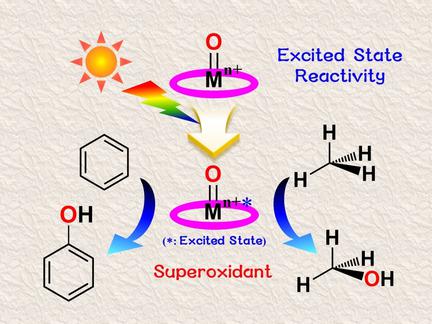当前位置:
X-MOL 学术
›
ChemPhotoChem
›
论文详情
Our official English website, www.x-mol.net, welcomes your feedback! (Note: you will need to create a separate account there.)
Photoinduced Generation of Superoxidants for the Oxidation of Substrates with High C−H Bond Dissociation Energies
ChemPhotoChem ( IF 3.7 ) Pub Date : 2019-12-17 , DOI: 10.1002/cptc.201900219 Namita Sharma 1 , Yong‐Min Lee 1 , Wonwoo Nam 1 , Shunichi Fukuzumi 1, 2
ChemPhotoChem ( IF 3.7 ) Pub Date : 2019-12-17 , DOI: 10.1002/cptc.201900219 Namita Sharma 1 , Yong‐Min Lee 1 , Wonwoo Nam 1 , Shunichi Fukuzumi 1, 2
Affiliation

|
Oxidation of substrates, such as methane, with large C−H bond dissociation energies usually requires harsh reaction conditions, such as high temperature and pressure. The use of photoexcited states of oxidants enables the oxidation of substrates which would otherwise be unable to react thermally. This Review focuses on photoinduced generation of strong inorganic and organic oxidants, which enables the oxidation of substrates with strong C−H bonds. For example, photoexcitation of a CeIV‐alkoxide complex results in the cleavage of Ce−O bond to produce an alkoxyl radical, which can abstract a hydrogen atom from methane to afford a methyl radical, leading to amination of methane with tert‐butyloxycarbonyl (Boc)‐protected monomethylhydrazine. Hydrogen atom abstraction from alkanes also occurs induced by the photoexcited state of tetrabutylammonium decatungstate, leading to alkylations and acylation of both aromatic and aliphatic N‐tosylimines. Photoexcitation of Bi‐ and V‐containing beta zeolites also results in hydrogen atom abstraction from methane to produce methanol at ambient temperature. The photoexcited state of a manganese(IV)‐oxo complex binding with two Sc3+ ions has a surprisingly long lifetime (6.4 μs), and is able to oxidize benzene to produce phenol. Chlorine radicals, that can be generated by photoinduced oxidation of chloride ion by the photoexcited states of oxidants or by photoexcitation of a chlorine dioxide radical, abstracts a hydrogen atom from alkanes including methane to produce alkyl radicals, which can be converted to the oxygenated products. Photoinduced oxidation of methane was also made possible by mixing photosystem II (PSII) and the membrane fraction of a particular form of methane monooxygenase. A PSII model reaction has been achieved by using p‐benzoquinone derivatives as plastoquinone analogues with a non‐heme FeII catalyst in the presence of H2O under photoirradiation, to yield dioxygen with the corresponding hydroquinone derivatives.
中文翻译:

具有高CH键解离能的底物氧化过程中光诱导的超氧化剂的生成
具有大量CH键解离能的底物(例如甲烷)的氧化通常需要苛刻的反应条件,例如高温和高压。氧化剂的光激发态的使用能够使底物氧化,否则底物将无法发生热反应。这篇综述着重于光诱导产生的强无机和有机氧化剂,它能够氧化具有强CH键的底物。例如,对Ce IV-醇盐络合物的光激发导致Ce-O键断裂产生烷氧基,该烷氧基可以从甲烷中提取氢原子以提供甲基,从而导致叔胺甲烷化‐丁氧羰基(Boc)保护的一甲基肼。丁烷四丁基铵的光激发态也会引起烷烃中氢原子的提取,从而导致芳族和脂族N-甲苯胺的烷基化和酰化。含Bi和V的β沸石的光激发也会导致在环境温度下从甲烷中提取氢原子以产生甲醇。锰(IV)-氧配合物与两个Sc 3+的光激发态离子具有惊人的长寿命(6.4μs),并且能够氧化苯以产生苯酚。氯自由基可通过氧化剂的光激发态通过光诱导氯化物离子的氧化而产生,或通过光激发二氧化氯自由基而产生,可从烷烃(包括甲烷)中提取氢原子以产生烷基基团,该烷基基团可转化为氧化产物。通过将光系统II(PSII)和特定形式的甲烷单加氧酶的膜级分混合,也可以实现甲烷的光诱导氧化。在H 2存在下,通过使用对苯二醌衍生物作为质体醌类似物与非血红素Fe II催化剂,实现了PSII模型反应。在光辐照下O,以产生具有相应氢醌衍生物的双氧。
更新日期:2019-12-17
中文翻译:

具有高CH键解离能的底物氧化过程中光诱导的超氧化剂的生成
具有大量CH键解离能的底物(例如甲烷)的氧化通常需要苛刻的反应条件,例如高温和高压。氧化剂的光激发态的使用能够使底物氧化,否则底物将无法发生热反应。这篇综述着重于光诱导产生的强无机和有机氧化剂,它能够氧化具有强CH键的底物。例如,对Ce IV-醇盐络合物的光激发导致Ce-O键断裂产生烷氧基,该烷氧基可以从甲烷中提取氢原子以提供甲基,从而导致叔胺甲烷化‐丁氧羰基(Boc)保护的一甲基肼。丁烷四丁基铵的光激发态也会引起烷烃中氢原子的提取,从而导致芳族和脂族N-甲苯胺的烷基化和酰化。含Bi和V的β沸石的光激发也会导致在环境温度下从甲烷中提取氢原子以产生甲醇。锰(IV)-氧配合物与两个Sc 3+的光激发态离子具有惊人的长寿命(6.4μs),并且能够氧化苯以产生苯酚。氯自由基可通过氧化剂的光激发态通过光诱导氯化物离子的氧化而产生,或通过光激发二氧化氯自由基而产生,可从烷烃(包括甲烷)中提取氢原子以产生烷基基团,该烷基基团可转化为氧化产物。通过将光系统II(PSII)和特定形式的甲烷单加氧酶的膜级分混合,也可以实现甲烷的光诱导氧化。在H 2存在下,通过使用对苯二醌衍生物作为质体醌类似物与非血红素Fe II催化剂,实现了PSII模型反应。在光辐照下O,以产生具有相应氢醌衍生物的双氧。



























 京公网安备 11010802027423号
京公网安备 11010802027423号